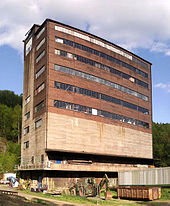San Fernando Mine
| San Fernando | |||
|---|---|---|---|
| General information about the mine | |||
| Funding / total | 6 million tons of iron ore | ||
| Rare minerals | Pyromorphite | ||
| Information about the mining company | |||
| Employees | 670 | ||
| Start of operation | March 27, 1855 | ||
| End of operation | July 15, 1958 | ||
| Funded raw materials | |||
| Degradation of | Spateisenstein | ||
| Greatest depth | 1,032.2 m | ||
| Geographical location | |||
| Coordinates | 50 ° 46 ′ 0 ″ N , 7 ° 57 ′ 40 ″ E | ||
|
|||
| local community | Herdorf | ||
| {{{NUTS3_BEZEICHNUNG}}} ( NUTS3 ) | Altenkirchen district | ||
| country | State of Rhineland-Palatinate | ||
| Country | Germany | ||
| District | Daaden-Kirchen mountain area | ||
The San Fernando ore mine is located in Herdorf ( Altenkirchen district ) on the road to Daaden . It was one of the largest and last still active ore mines in Herdorf.
history
The unusual name goes back to the Herdorf miner Wilhelm Hähner, who initially worked for several years in mining in Mexico , then returned to his homeland and found and named the mine field in the Sottersbachtal . HDF Schneider bought this mine field and some neighboring fields on August 1st, 1856 in order to set up the mine . On March 27, 1855 a workforce came together. From 1912 the mine belonged to Friedrichshütte.
The ore mined here belongs to the Florz-Füssenberger gangway , other mines were also in this gangway; Wolf , chance luck , Füssenberg - Friedrich Wilhelm and Glaskopf . Above all, spate iron stone, brown iron stone, magnetic iron stone and, to a lesser extent, non-ferrous metal ore were mined.
The ore was processed above ground in large plants, mainly by roasting . The end product (Rost I or Rost II) was brought to the hut in Herdorf on a narrow-gauge railway along the Sottersbach. The mine was closed between March 15, 1945 and February 4, 1946, and in 1953 the mine was connected to Erzbergbau Siegerland AG . On July 15, 1958, it was finally shut down. Until March 31, 1962 it belonged to the Füssenberg mine.
A number of the buildings remained intact for decades, such as the tower-like ore processing building . Some smaller buildings are used by the Thomas Magnete company . The former wash house is used, for example, as a test hall for endurance tests, and the characteristic pulleys can still be seen on the ceiling.
In 2016, almost all of the remaining buildings were demolished. The site is required by the Thomas Magnete company to expand the site. At the height above the Sottersbachtal only the former machine house of the mine still stands.
Promotion and workforce
Most recently, 17,000 tons of raw spar were mined monthly. The total production of the mine is 6 million t, the reserves with Friedrich-Wilhelm / Füssenberg are estimated at 4–6 million t.
- Production in 1900: 24,406 t
- Production in 1913: 72,000 t
- Production 1955: 135,173 t
In its heyday 928 people worked here; in 1955 there were 387; 1958 490 miners.
Shafts
Civil engineering began in 1881. There were three shafts:
- 1881: blind shaft; 4.72 × 1.60 m in size, 357.2 m depth .
- 1906: shaft I; 675 m depth; electric promotion
- 1918: shaft II; 1001.97 m depth; in operation from 1928
The total depth was 1032.2 m.
literature
- Titus Kötting: My life as a miner , Verlag Stössel, Betzdorf, 2005.
- Ute Bosbach: Searching for traces in Eisenland - On the way on ore roads and miners ' paths, amadeusmedien, November 2006. ISBN 3-9808936-8-5
- Irene Ansorge, Jürgen-H. Saddle guard: Made of iron is the mountains ... Mark . Siegerland Museum, Siegen
See also
Web links
Individual evidence
- ↑ San Fernando: The Colossus is up to the collar , added Dec. 3, 2017


